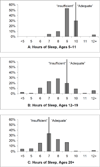Insufficient sleep in young patients with diabetes and their families
- PMID: 21278167
- PMCID: PMC3617552
- DOI: 10.1177/1099800410395569
Insufficient sleep in young patients with diabetes and their families
Abstract
Objective: We examined sleep in families of individuals with type 1 diabetes and the relationship of sleep with obesity, diabetes, and insulin resistance.
Methods: Probands with type 1 diabetes diagnosed before age 18 and first- and second-degree relatives were included (n = 323). Demographic, anthropometric and clinical variables, and self-reported sleep duration and napping were assessed.
Results: On average, adults (≥20 years) slept 7.5 (SD 1.5) hr, whereas children (5-11 years) and adolescents (12-19 years) slept 9.8 (SD 1.1) and 8.5 (SD 1.9) hr, respectively (p < .01). Based on national recommendations, 40.9% of participants slept insufficiently, particularly young people (vs. adults, p < .01). In age-group stratified analysis, there were no significant associations of insufficient sleep or sleep duration with obesity, diabetes status, or insulin resistance after adjustment for age, race/ethnicity, and gender. In all, 42% of participants reported napping regularly (≥1/week), with adolescents significantly more likely to do so (vs. adults, odds ratio [OR] = 1.95, p < .01). Non-Hispanic Blacks and Hispanics also had higher odds of regular napping (vs. non-Hispanic Whites, OR = 3.74, p < .01 and OR = 2.52, p = .03, respectively). In adjusted analysis, leaner (vs. obese) adolescents, whether measured by body mass index, percentage body fat, or waist circumference, were significantly more likely to nap regularly.
Conclusions: We found that insufficient sleep was significantly more likely in children and adolescents compared with adults in families with type 1 diabetes. Lower adiposity was associated with regular napping in adolescents. The high prevalence of insufficient sleep in young patients with type 1 diabetes and their relatives detected in the current study may have significant health consequences.
Conflict of interest statement
Declaration of Conflicting Interests: The authors have nothing to declare.
Figures

References
-
- Ayas NT, White DP, Al-Delaimy WK, Manson JE, Stampfer MJ, Speizer FE, Hu FB. A prospective study of self-reported sleep duration and incident diabetes in women. Diabetes Care. 2003;26:380–384. - PubMed
-
- Beregszaszi M, Tubiana-Rufi N, Benali K, Noel M, Bloch J, Czernichow P. Nocturnal hypoglycemia in children and adolescents with insulin-dependent diabetes mellitus: Prevalence and risk factors. Journal of Pediatrics. 1997;131:27–33. - PubMed
-
- Chen X, Beydoun MA, Wang Y. Is sleep duration associated with childhood obesity? A systematic review and meta-analysis. Obesity. 2008;16:265–274. - PubMed
-
- Expert Panel on the Identification, Evaluation, and Treatment of Overweight in Adults. Clinical guidelines on the identification, evaluation, and treatment of overweight and obesity in adults: Executive summary. American Journal of Clinical Nutrition. 1998;68:899–917. - PubMed
Publication types
MeSH terms
Grants and funding
LinkOut - more resources
Full Text Sources
Medical
Research Materials

